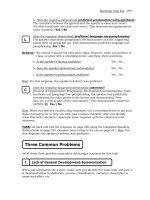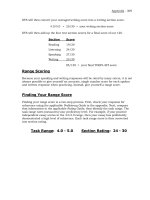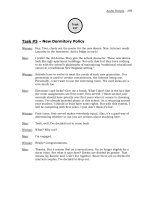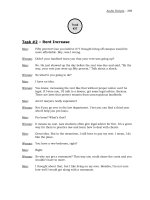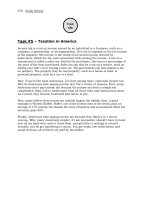Speaking and Writing Strategies for the TOEFL iBT part 40
Bạn đang xem bản rút gọn của tài liệu. Xem và tải ngay bản đầy đủ của tài liệu tại đây (167.1 KB, 5 trang )
378 - Audio Scripts s
Task #5 – Taxation in America
Income tax is a tax on income earned by an individual or a business, such as a
company, a partnership, or an organization. This tax is imposed on the net income
of the taxpayer. Net income is the result of all earned income reduced by
deductions, which are the costs associated with earning the income. A tax on a
transaction is called a sales tax. Paid by the purchaser, this tax is a percentage of
the price of the item purchased. Sales tax can also be a tax on a service, such as
having your hair cut or buying a new car. The government can also impose a tax
on property. The property may be real property, such as a house or land, or
personal property, such as a car or a boat.
Now, if you’re like most Americans, you hate paying taxes, especially income tax.
Why do Americans hate paying income tax? For a variety of reasons. First, many
Americans don’t pay income tax because the income tax form is simply too
complicated. Many fail to understand what all those lines and instructions mean.
As a result, they become frustrated and refuse to pay.
Next, many believe that income tax unfairly targets the middle class. A good
example is Warren Buffett. Buffet, one of the richest men in the world, pays an
average of 17% income tax thanks his army of lawyers and accountants while his
secretary pays 30%.
Finally, Americans hate paying income tax because they think it is a tax on
success. Why, many Americans wonder, if I am successful, should I have to hand
over all my hard-won cash to Uncle Sam, and get little or nothing in return?
Actually, you do get something in return. You get roads, law enforcement and
social services, all of which are paid by tax dollars.
Track
#36
Glossary - 379
academic formal level of education at an institution of higher
learning, such as a community college or university.
ambiguous not clear; having more than one meaning
argument a. the process of arguing with the purpose of persuading
or informing an audience;
b. a summary of the main points in a literary work
automaticity done automatically
CBT acronym for computer-based TOEFL test
claim to take a position; to express an opinion
coherence demonstrating an orderly, logical and aesthetically
consistent relation of parts; writing and speaking in a clear
and consistent manner
context situation; position in time; the background story
deduction a form of logic in which a series of premises leads to a
conclusion
distractor for TOEFL, information purposefully inserted into a
question, essay or dialogue that sounds important but is
not; information that distracts you from the right answer
essay a written argument
ETS acronym for Educational Testing Services, the designer
and implementer of TOEFL world wide; located in
Princeton, New Jersey, USA; www.ets.org
evidence facts to support an opinion, claim or conclusion
fluency speaking smoothly and easily; naturally
iBT acronym for internet-based TOEFL test
incoherent lacking coherence; not clear, not intelligible
Glossary
380 - Glossary y
induction a form of logic in which a conclusion is inferred from
examples or evidence
lecture a verbal argument or summary of facts
main topic the main subject or main idea in an argument
off topic not focused on the main topic
on topic focused on the main subject
obscured hidden; not clear or easily understood
opinion a belief, conclusion or claim; also a thesis
G+TiC a paragraph argument map that uses deduction as a
method of organization: G
(general statement = opinion or
premise) + T
ransition + illustration + Concluding sentence
G+TiC=C a three-part argument map that uses deduction as a
method of organization: G (general statement = opinion or
premise) + TiC (body paragraph) = C (conclusion)
G+2TiC=C a four-part argument map that uses deduction as a method
of organization: G (general statement = opinion or premise)
+ 2TiC (two body paragraphs) = C (conclusion)
G+3TiC=C a five-part argument map that uses deduction as a method
of organization: G (general statement = opinion or premise)
+ 3TiC (three body paragraphs) = C (conclusion)
pace the speed at which one speaks; a slow pace, a fast pace
PBT acronym for paper-based TOEFL test; the original TOEFL
test
premise something considered to be true or factual; used as a
starting point for reasoning or for taking action
proficient demonstrating skill and knowledge
prompt something that moves you to take action; for TOEFL, a
question to be answered either verbally or in writing
pronunciation the act of producing sounds based on an accepted standard
of correctness
range a set area; the distance between two points or numbers
Glossary - 381
rater for TOEFL, a person trained by ETS to rate (measure)
test-taker speaking and writing proficiency according to a
set of standardized rubrics
rhetorical strategies methods speakers and writers use to develop arguments
rhetorical question a question to which no answer is expected
rubrics a set of rules; standards
syntax the rules of language; grammar
thesis an unproved statement used as a premise in an argument;
a claim advancing a point of view in an argument
2TiC=C a three-part argument map that uses induction as the
method of organization: 2TiC (two body paragraphs) = C
(conclusion)
3TiC=C a four-part argument map that uses induction as the
method of organization: 3TiC (two body paragraphs) = C
(conclusion)
to blank out to forget suddenly; to stop thinking suddenly
to construct for TOEFL, to develop and deliver verbal and written
arguments
to digress to move in a different direction
to formulate to develop; to construct
to imply to see or read a suggestion in a statement
to infer to make a conclusion based on the facts presented in a
statement
to map out to show graphically how different parts logically connect
to construct a whole; to make a plan
to flame to scream at someone in writing using capital letters
to rate for TOEFL, rating (measuring) the proficiency of verbal and
written arguments according to a set of standardized
rubrics
to overstate to say too much; to exaggerate
verbal spoken
382 - Glossary y
Master the LSAT (608 pages; includes software and 4 official exams)
GMAT Prep Course (624 page; includes software and online course)
The MCAT Physics Book (444 pages)
The MCAT Chemistry Book (496 pages)
SAT Prep Course (640 pages; includes software)
Law School Basics: A Preview of Law School and Legal Reasoning (224 pages)
Vocabularly 4000: 4000 Words for an Educated Vocabulary (160 pages)
Nova Press
11659 Mayfield Avenue
Los Angeles, CA USA 90049
1-800-949-6175
www.novapress.net
Also From Nova Press
